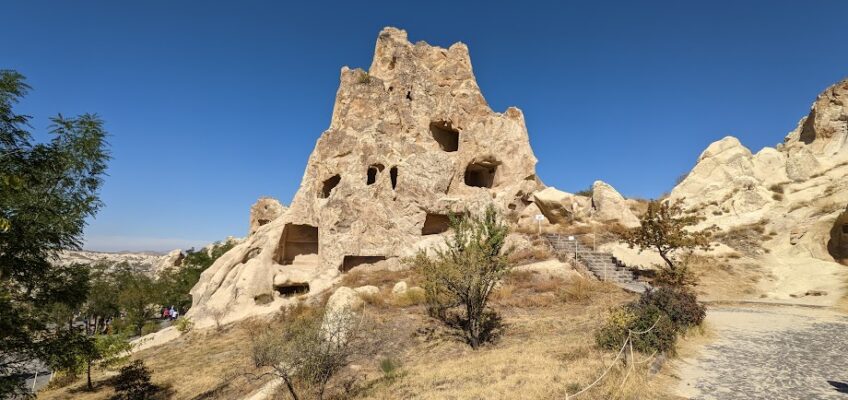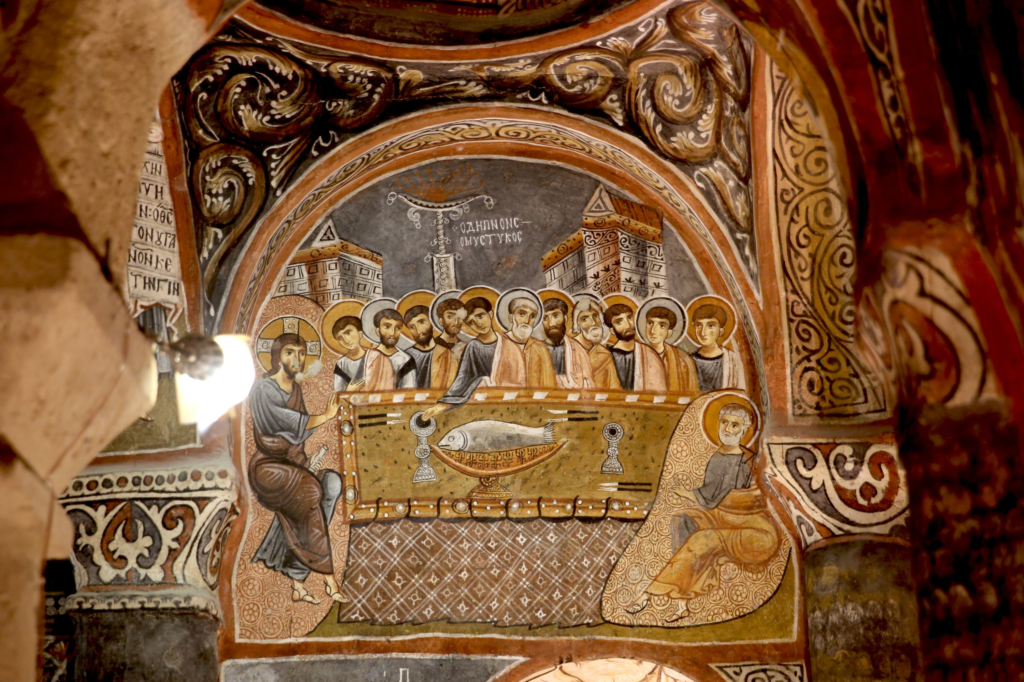I’ve seen a lot of pictures of Cappadocia, and I knew there were caves and rocks, but until I saw it for myself, I really had no idea what it was all about. Today was a revelation.
Arrival
I flew from Antalya to Kayseri early this morning. At Antalya Airport I was sitting in the waiting area along with everyone else. There was no pre-flight activity, no one gathering at the desk or trying to be first in line.
Suddenly a woman working at the desk shouted, “Boarding time! Boarding time!” That’s all. No pre-boarding. No zones. Everyone got up and crowded haphazardly at the gate, and we showed our boarding passes and got on the bus that took us to the plane. When boarding was complete, they shut the doors and we left, fifteen minutes early.
Arriving at Kayseri, I walked out the front of the airport and met my driver, who was holding up a list of about six names. So we waited a good half hour until everyone was assembled, and we walked to the van and crowded in. He could barely fit all the luggage in back, and the van was full, noisy with rattles, and uncomfortable The drive to Cappadocia was about an hour, and I had no idea what was happening. I expected to be met by a tour guide. The driver said nothing the entire drive.
Finally as we got to the Cappadocia area, he pulled off at the side of the road, consulted his official paper, and called my name. My guide was going to meet me there. I got off, he dug my luggage out of the back, and just then another van pulled up. Ibrahim, my guide for the day, got out and welcomed me. And there also were Steve and Rachel, my friends I toured Istanbul with for two days and visited Ephesus with as well.
What is Cappadocia anyway?
I admit up until now I wasn’t clear about what Cappadocia is. I think I had the impression it was an ancient city, like Ephesus or Perge. But it is actually a region.
You can read about the history of Cappadocia on Wikipedia if you’re interested. Today, tourists flock to Cappadocia partly for the historic structures–monastic communities with houses, chapels, and churches carved into soft volcanic rock–and partly for the extraordinary topography, with huge rocks eroded into shapes commonly referred to as “fairy chimneys,” or resembling minarets and pillars. Some of this I got to see today, and I’ll see more tomorrow.
Göreme Open Air Museum
This was our first stop on today’s tour. It’s hard to describe, so here are a couple of photos (also see the one at the top of this post).
The caves served as houses, chapels, and churches. They were carved into the soft volcanic stone using chisels. The time period predates the arrival of Christianity, but in the 9th century monks and hermits came and formed monasteries and retreats, attracted by the opportunity pursue a comtemplative life. Then Christian pilgrims began to arrive. As the population grew, more private chapels and houses were built.
The most impressive space in the museum is the Dark Church. The frescoes in the church are brilliantly colored. And since sunlight has never infiltrated, the colors have never faded.
Photos weren’t allowed, by I took a couple surreptitiously.
Devrent Valley
Our next stop was Devrent Valley, also known as Imagination Valley, because if you use your imagination, you can see all sorts of things in the rock formations.
For me, the interest is more geological and aesthetic. I am fascinated by the way nature can create such interesting landscapes. I’m not really drawn toward ascribing meaning. But yes, I did see a camel, and I did see two birds kissing.
Lunch
This lunch place was very touristy. We tourists love eating in caves.
Ceramics
After lunch I said goodbye to Steve and Rachel, since they already visited the ceramics place (Venessa Seramika) yesterday.
After a demo, which you can see pictures and video of in my album, I got to go shopping.
As I previously mentioned, shopping can be fun or annoying, depending on what they’re selling. But I’m pretty passionate about ceramics, so I was not annoyed at all, and I succumbed and bought a piece way beyond my budget. It’s a tile by Saim Kolhan, a ceramic artist whose work has been recognized by UNESCO for its cultural significance. The piece is being shipped home, and I neglected to take a photo, but I’ll post it with my other photos when I get it.
Ürgüp
My hotel, the Hasse Cave Konak, is one of many cave hotels in the area. Ürgüp, like most of the towns in this area, was once filled with houses built into caves. Today most of those houses are hotels. The transformation occurred over the last fifty years. Prior to the 1970s, Cappadocia saw few tourists.
After I checked in to my hotel, I went for a walk through town. You can find photos in my album.
Right now I’m going to bed. I am being picked up tomorrow morning at 5:10 for the quintessential Cappadocia tourist activity.











Florence
Beautiful, breathtaking, awesome and wonderful in the sense that it is all filled with wonder!